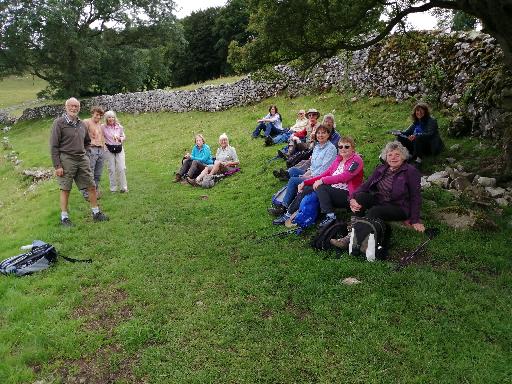| JOURNAL 2022 |
| North Craven Heritage Trust |
This was our first in-person event for 18 months, laying down its own small marker in NCHT’s history. Numbers were limited and the duration was kept to a half day to minimise Covid infection risk.
Starting in Stainforth car park we briefly romped through Stainforth’s history from the Bronze Age Stainforth cairn (just about visible), through ownership by Sawley Abbey, to the dissolution. Crossing the Ribble at the Packhorse Bridge, we moved to the non-monastic ‘Knight Stainforth’. The succession of ownership by establishment worthies was broken by one of their number, Samuel Watson, becoming a Quaker in the 1650s and – horror of horrors – holding Quaker Meetings in Knight Stainforth Hall. Our first mill – a corn and later a cotton mill – lay just to the north of the bridge which had been re-built by Samuel Watson.
Following the Ribble downstream, past our first waterfall, we had fine glimpses of Taitlands, built in the 1830s by Thomas Redmayne, a Stainforth lad made good, although his expensive tastes eventually undid him. By now we were back on monastic land, under Furness Abbey’s wing. Another mile or so brought us opposite our second mill, Langcliffe Old Mill. From the thirteenth century this has produced flour, rag paper, paper from wood pulp and waste. Now it is a thriving stone mill.
A few hundred yards later we were opposite our third and final mill, Langcliffe High Mill. Starting life as a corn mill in the 1160s, it was built by Furness Abbey, but on the easier-to-work Sawley side of the river. This occasioned an unholy row between the abbeys which eventually drew in the Pope to adjudicate. This mill now converts paper but previously was involved spinning, doubling, weaving with the odd bankruptcy.
At Locks we crossed back over the river. A welcome coffee break at the end of Pike Lane set us up for the climb to Winskill, the site of our ‘bercaria’, or monastic sheep farm, associated with Sawley Abbey, with evidence of field systems from that period. Under the care of Tom Lord the farm has become a haven for meadow flowers and butterflies, as well as sheep, pointing the way to more modern, sustainable upland farming.
On the plateau we looked at traces of evidence for Bronze Age field systems and further afield at the splendid views of Fountains Fell, Pen-y-Gent and Ingleborough. From the top of Goosecar we diverted into the atmospheric splendour of Catrigg Force, the second of our waterfalls. The walk back to Stainforth followed a monastic route over three cattle creeps of more recent date, running between walls which we tried to date. This had been a memorable day, stepping back into history while enjoying good company and the freedom to meet again after so many months of lockdown.
